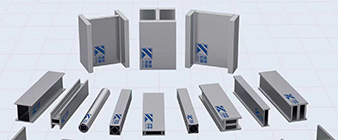When considering the use of stainless steel hollow structural profiles in water treatment applications, 1.4410 stainless steel offers several key advantages over other stainless steel grades:
1.4410 is a duplex stainless steel with high chromium (24-26%) and molybdenum (2.5-3.5%) content that provides excellent resistance to pitting, crevice and stress corrosion cracking.
Compared with austenitic stainless steels such as 304 or 316, 1.4410 has excellent corrosion resistance, especially in chloride-containing environments such as seawater or brackish water.
The dual-phase microstructure of 1.4410 also enhances its overall corrosion resistance, making it a more suitable choice for water treatment applications.
1.4410 stainless steel hollow structural profiles have high tensile strength and yield strength, usually in the range of 700-900 MPa and 500-650 MPa respectively.
This high strength-to-weight ratio allows the design of lighter, more efficient structural elements, optimizing material use and reducing overall system weight.
The excellent mechanical properties of 1.4410 ensure the structural integrity of the hollow profiles, allowing them to withstand the static and dynamic loads encountered in water treatment applications.
1.4410 maintains its mechanical properties and corrosion resistance over a wide temperature range from high to cryogenic conditions.
This thermal stability is particularly beneficial for water treatment applications involving temperature fluctuations, such as desalination plants or cold climate water storage facilities.
Resistance to brittleness at low temperatures also makes 1.4410 stainless steel suitable for use in cold climate water treatment environments.
1.4410 stainless steel is easy to weld, but welding parameters require careful control of the welding parameters to maintain the desired ferrite-austenite balance.
The high strength and ductility of 1.4410 make it suitable for a variety of manufacturing techniques, including rolling, bending and welding, allowing the production of hollow structural profiles with different cross-sectional shapes and sizes.
This manufacturing flexibility enables the design and construction of complex water treatment structures and components using 1.4410 stainless steel.
1.4410 stainless steel generally has a wider range of applications and may cost slightly less than the more specialized 2507 (UNS S32570) superduplex stainless steel.
This wider availability and potentially lower cost could make 1.4410 a more accessible and cost-effective option for certain water treatment projects where slightly lower corrosion resistance compared to 2507 may be acceptable Accepted.
In summary, the combination of excellent corrosion resistance, high mechanical strength, thermal stability and manufacturing flexibility make 1.4410 stainless steel a favorable choice for hollow structural profiles in water treatment applications. While 2507 superduplex stainless steel may have slightly superior corrosion resistance, the cost-effectiveness and widespread availability of 1.4410 make it a viable and often preferred choice for many water treatment projects.
-
 2024-9-15 EN 1.4301 / 304 / 1.4307 / 304L performance and advantages
2024-9-15 EN 1.4301 / 304 / 1.4307 / 304L performance and advantages -
 2024-9-19 UNS S32570 VS 1.4410 stainless steel structural profile
2024-9-19 UNS S32570 VS 1.4410 stainless steel structural profile -
 2024-9-25 Introduction to 254SMO and UNS S31254 Super Stainless Steel
2024-9-25 Introduction to 254SMO and UNS S31254 Super Stainless Steel -
 2024-9-27 C22 / 2.4602 Nickel-Based Alloy Structural Profiles: Beams and Columns
2024-9-27 C22 / 2.4602 Nickel-Based Alloy Structural Profiles: Beams and Columns -
 2024-9-29 Alloy 59 / 2.4605 Nickel-Based Alloy Hollow Structural Profiles
2024-9-29 Alloy 59 / 2.4605 Nickel-Based Alloy Hollow Structural Profiles -
 2024-9-20 Ti Gr 7/3.7235/UNS R52400 Application of structural profiles in chemical energy
2024-9-20 Ti Gr 7/3.7235/UNS R52400 Application of structural profiles in chemical energy -
 2024-9-19 UNS S32570 stainless steel hollow structural profile
2024-9-19 UNS S32570 stainless steel hollow structural profile



